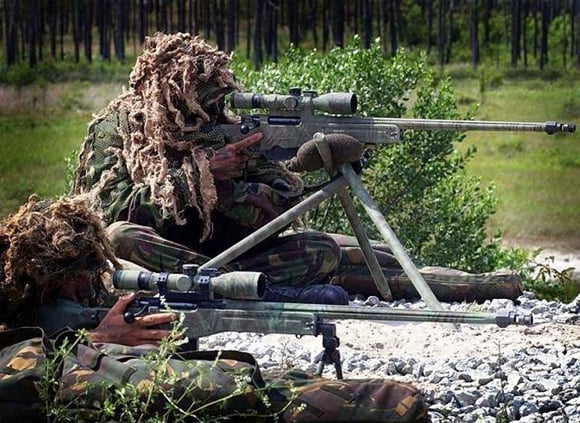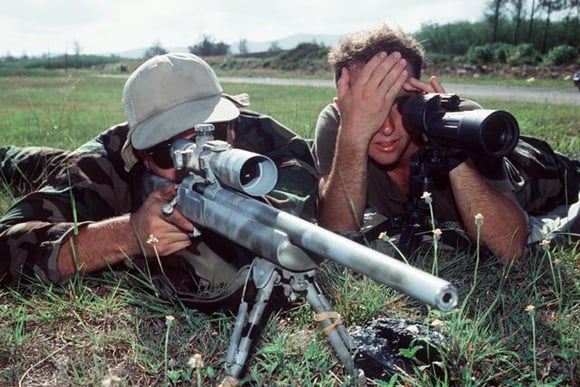Original URL: https://www.theregister.com/2010/05/25/darpa_terry_pratchett_gunsights/
Computing smart-scope gunsight for US snipers
Terry Pratchett gizmo makes long shots hit 6 times out of 10
Posted in Science, 25th May 2010 13:12 GMT
US military boffins are about to produce a field-ready computer gunsight which will let snipers kill people on their first shot from a mile away - even with troublesome winds blowing.
The technical issues facing the so-called "One Shot" project have already been solved using prototype equipment, and it is now planned to produce 15 "fully operational and field hardened" sets of gear for further development trials on the battlefield.

This is how it's done nowadays.
Modern-day sniper rifles can easily throw their bullets across tremendously long distances, but beyond a certain point it becomes impossibly difficult to adjust the aim to allow for atmospheric effects - in particular for the wind. It can also be a time-consuming business allowing for all the changing factors which can affect the path of a bullet's flight - range, temperature, atmospheric pressure, the spin of the projectile itself, the relative heights of the target and shooter.
Thus it is that very long-range hits beyond 2km do get made, but they are rarities. The current combat sniping record is nowadays generally credited to Corporal of Horse* Craig Harrison of the British Army, who hit and killed two Taliban machine-gunners at a distance of 2,474 metres in November last year in as many shots and then destroyed their weapon with a third round. However, he missed several times before getting the necessary corrections nailed down so expertly.
Harrison was able to make these astonishing shots because - in his words - "conditions were perfect, no wind, mild weather, clear visibility".
The previous record-holder, Corporal Rob Furlong of the 3rd battalion, Princess Patricia's Canadian Light Infantry, killed an al-Qaeda gunman at 2,430m in 2002 - but like Harrison took several shots before scoring a hit. Furlong may also have been aided by the thin air high in the Shah-i-Kot valley where he was fighting at the time.
First breadboard, then brassboard. Then it's ready for the brass hats to see it
But in general, even powerful sniper rifles like Harrison's L115A3 Long Range Rifle (aka the Arctic Warfare Super Magnum** from Accuracy International) aren't expected to achieve a first-shot kill further off than 600m, and "harassing fire" to 1100m. In particular, the estimation of crosswinds between the shooter and the target is usually a matter of educated guesswork. Then, making the right corrections for range, height, bullet spin, temperature, air pressure etc can take so long that the target has moved away before the sniper can shoot.
But it seems that there's no need for this to be the case. US military trials have found that a laser beam shone on the target can do more than just determine the range: it can also be used to "measure the average down range crosswind profile". The laser information can be combined with automatic readings of temperature, humidity etc and a "ballistic solution" computed.
Then a set of artificial crosshairs can be generated in the rifle showing where the bullet will actually strike. These can then be moved onto the target. Alongside the crosshairs is a constantly updated readout of how reliable the calculated aim point is and how likely it is to shift during the time the bullet is in flight (perhaps several seconds at long ranges). This lets the sniper choose the right time to shoot.

That spotting scope is ridiculously old-fashioned. Let's pimp that baby up some.
Such equipment has been tried out by US snipers working with a "brassboard" prototype setup (that is, one a bit more developed than a breadboard rig, but still not ready for actual field use). According to the "One Shot" project's managers:
The brass-board system was tested by trained snipers and designated marksmen under varying environmental conditions up to 1100 meters and 5-8 m/s average crosswinds. The brassboard system demonstrated a marked capability as compared to current sniper system. Under all test conditions, the brassboard system significantly improved the first round hit probability, required fewer rounds, and less time to get the first hit vs users without the One Shot system.
Now the idea is to integrate the brassboard equipment into a special nightsight/thermal/optical telescope instrument to replace the one carried by the sniper team's spotter, linked either wirelessly or by a cable to a display widget attached to the scope on the sniper's rifle. The new smartscope will hold the various lasers, instruments and calculating hardware necessary to generate the virtual crosshairs in the gunsight display.
These days, million-to-one shots come off six times out of ten
The system is to be fully ruggedised and ready for field use, and will be capable of identifying a target as hostile and measuring crosswinds out to 1500m in daylight (and lesser ranges using thermal or nightsight vision in the dark). There's to be a menu allowing it to be used with the most common sniper/marksman rounds: 7.62mm NATO, .338 Lapua magnum and .300 Winchester magnum.
Fifteen hundred metres doesn't come close to the record-breaking efforts of Harrison, Furlong and the legendary Carlos Hathcock before them: but those were exceptional circumstances. Most professional snipers on most days would be very impressed by a first-round hit at 1500m.
Given the nature of the project it's no surprise to find that our old friends at the Pentagon bonkers-boffinry bureau DARPA are behind One Shot. It is, after all, a machine for making sure that extremely unlikely feats can be achieved almost every time - DARPA's institutional desires writ short. The project might almost have been dubbed the Discworld-effect generator or similar: it's well known that in Terry Pratchett's magical universe million-to-one shots come off nine times out of ten. (Actually DARPA are only asking for a 60 per cent chance of a first shot kill, but there.)
One Shot is actually quite realistic and achievable for DARPA, in fact: similar technology has already been demonstrated in the computing gunsight of the XM-25 smartgun, which is able to lob a miniature 25mm exploding shell with such precision it will explode just beyond a street corner, windowsill, trench parapet etc to shower a hidden enemy with shrapnel regardless of his protective cover.
True, hardcore DARPA fans will have to wait for the related EXACTO project, in which a heavy .50-calibre bullet will be furnished with guidance fins allowing it to steer itself in on a laser dot like a tiny smartbomb - presumably scoring first-shot kills at ranges of 6,000 or even 7,000m, making One Shot look like old hat.
That really does sound like DARPA - making tomorrow's technology obsolete today.
Full details on One Shot can be read in pdf here. ®
Bootnotes
*A unique rank used by Harrison's unit, the Household Cavalry, equivalent to a sergeant in most other formations. The Household cav don't use the title "sergeant" at all; this was formerly the case for all British cavalry regiments, but only the Household ones still keep the custom up.
Regimental tradition holds that the thinking behind this lay in the fact that the word "sergeant" derives from the Latin for "servant". As in former times even the lowliest Household trooper would have been a gentleman and an aristocrat, such a title would never be tolerable.
**Arctic conditions are the toughest ones for a sniper rifle designer to overcome: the weapon is suitable for use in all climates. British snipers mostly use the .338 Lapua magnum cartridge.